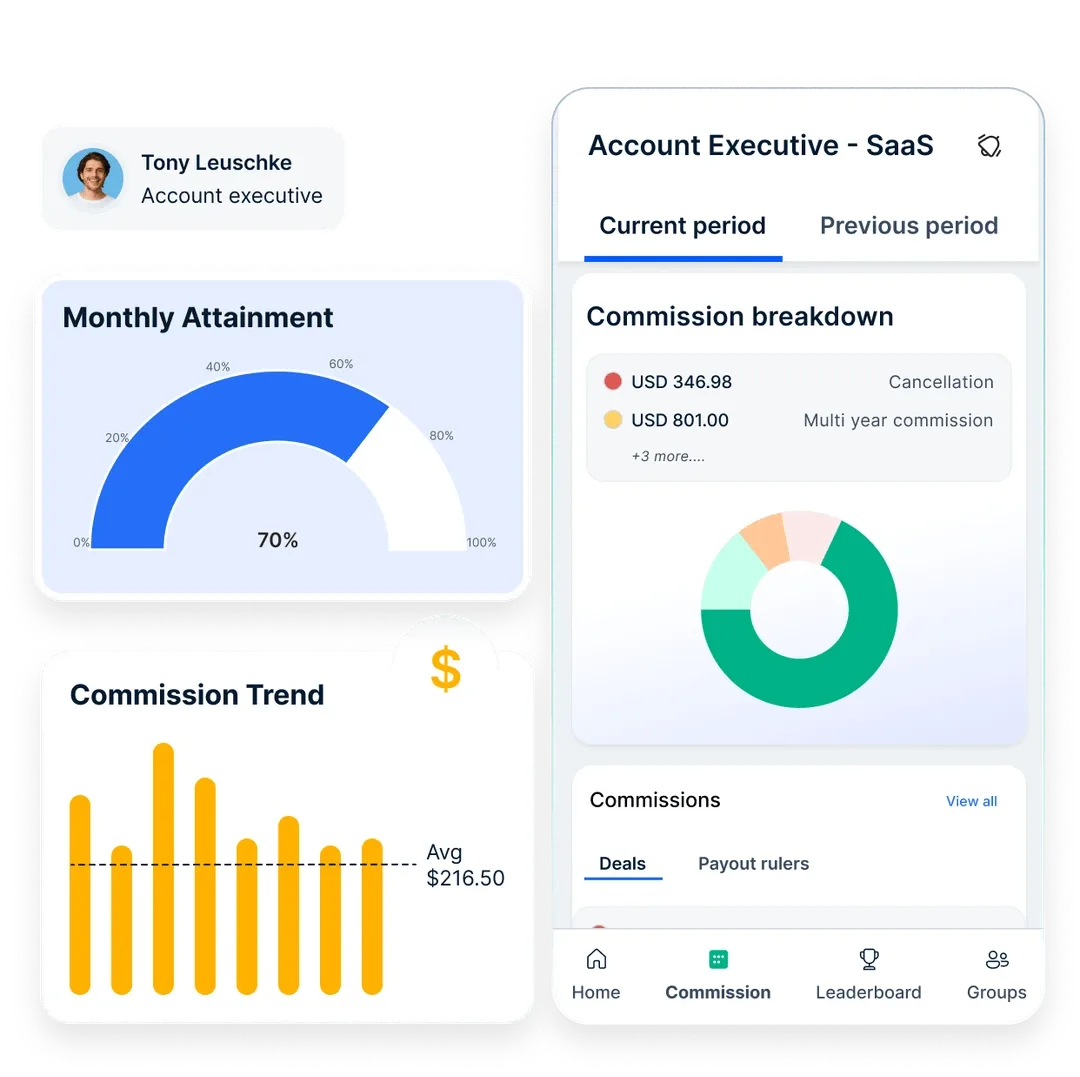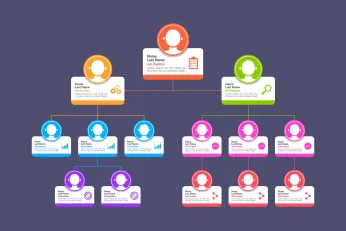13 Sales Performance Metrics You Must Track for Success in 2025
Tracking the right sales performance metrics is key to improving efficiency and closing more deals. This guide explores 13 must-track sales rep productivity metrics that help measure success, optimize processes, and drive better results.
On this page
Tracking sales performance metrics is essential for understanding what’s driving revenue and where improvements are needed. Without clear insights, businesses risk relying on guesswork instead of data-driven decisions.
Sales teams juggle multiple tasks, from prospecting to closing deals, but not all efforts lead to results. That’s why focusing on the right sales rep productivity metrics helps identify bottlenecks, optimize workflows, and improve efficiency. Whether it's measuring deal conversion rates, sales cycle length, or quota attainment, these metrics provide a clear picture of performance.
Strong sales rep performance metrics go beyond just revenue—they assess efficiency, customer engagement, and overall sales effectiveness.
This guide explores the key sales performance metrics that matter most, helping businesses refine strategies, boost sales productivity, and drive consistent growth.
What are sales performance metrics?
Sales performance metrics are measurable indicators that help businesses track and evaluate the effectiveness of their sales efforts. These metrics provide insights into how well sales teams, individual reps, and overall sales strategies contribute to revenue generation.
Tracking the right sales rep productivity metrics ensures that teams focus on high-impact activities, while sales rep performance metrics help identify areas for improvement, optimize sales processes, and drive better results.
Sales performance metrics typically include key indicators like conversion rates, average deal size, sales cycle length, quota attainment, and customer acquisition cost. These data points help businesses refine their strategies, allocate resources efficiently, and ensure sales teams are meeting their targets.
13 Sales performance metrics you must track
To help you decide which sales KPIs to focus on, we have put together a guide to the sales performance metrics that matter, which not only tells you what these KPIs are and elaborates on their utility but also shows you how each of them can be applied in day-to-day business situations.
1. Lead response time
Lead response time refers to the time sales reps take to follow up on leads. The research is unequivocal about the criticality of this sales metric when it comes to qualifying prospects.
According to HubSpot, there is a 100x chance of qualifying a prospect if the salesperson reaches out within five lead creation minutes. Inside Sales states that the lead qualification rate increases 21 times when a lead is contacted within 5 minutes instead of after 30 minutes.
Putting it to work:
For each salesperson, this key performance metric is calculated by taking the time taken between lead creation and first response for each of the leads assigned to them and then dividing that total by the total number of leads.
2. Sales productivity
Sales productivity or the time spent selling is an essential measure of sales team performance. Highly efficient teams typically spend a large proportion of their time on high-impact activities, such as prospecting and client meetings, and only a tiny proportion of it on low-impact activities, such as administrative tasks and tracking their commissions.
Another component of sales productivity is effectiveness. Two sales teams who spend the same amount of time selling may achieve different results. In such cases, the team that achieves better results is said to be the more effective one.
Putting it to work:
This metric is a product of efficiency and effectiveness. For example, touching base with 20 qualified prospects instead of using the time for accounting tasks is a case of high efficiency and high effectiveness.
Creating email templates to reach out to prospects over emailing each one individually, on the other hand, is a case of high efficiency. However, the latter method may be more effective. Here, the efficiency of the former dwarfs the effectiveness of the latter.
3. Sales funnel leakage
Have you ever wondered where in your funnel your prospects drop out and at what rate? This is the question that this metric answers. To determine where your sales process is the weakest, the conversion rate at each of its stages needs to be calculated. Better sales results can be achieved by identifying these weak areas and fixing the issues discovered therein.
Putting it to work:
Assume that 50% of fresh leads agree to get on a call, 40% of this set agrees to a demo, and 10% of this set become customers. The high rate of drop-offs at the last stage may indicate that the demos being given are ineffective or that the leads are not being qualified enough.
The issues may be varied, but once you have identified these potential problems, it becomes easier to pinpoint the actual issue and take action.
4. Win rate
Also known as the conversion rate, this metric measures the percentage of leads that ultimately become customers. It also helps determine the number of leads you need to have in place to reach your revenue targets.
Over time, if the number of deals being closed remains the same while the win rate is rising, it indicates that your sales team’s performance is improving. On the other hand, if your sales team is closing the same or fewer deals and the win rate is also decreasing, it indicates that something about your lead generation or other sales processes isn’t working.
Putting it to work:
Suppose you can identify 600 leads in a given month, of which 120 become customers, then your win rate is said to be (600/120) = 20%.
If your win rate is 20%, your revenue target 100k, and your average deal size 10k, you need 10 deals to reach your revenue target, and (20/100) x = 10, where x is the number of leads required. Here, the number of leads required, i.e., x, is 50.
Did you know? Using a gamified approach to sales with a product with built-in game mechanics can boost sales productivity and directly grow your MRR?
Hint: You might want to see what Compass goal performance all is about.
5. Average deal size
This metric tells you how direction your deal size is moving - up, down, or staying the same. Average deal size can be useful if you’re trying to move upmarket (in which case you want the metric to go up) or down-market (in which case you’re trying to land more SMB customers and want the metric to go down) from where you are currently.
It also helps keep an eye out for reps for whom this metric is lower than the team average, as this could mean they are going after the low-hanging fruit and may need to target larger clients. Or it could be a case of aggressive discounting.
Putting it to work:
Average deal size is calculated by dividing the total value of deals closed by the total number of deals. For example, if the company closed two deals worth 500k and 300k each, the average deal size is 400k. In other words, if you have a sales representative whose revenue target is 800k and the average deal size is 400k, then two deals need to be closed to meet the target.
6. Revenue
And now for the most crucial sales KPI - revenue or gross income. While this may seem like a fairly straightforward metric involving gross sales with discounts and the value of returned goods factored in, there is more to it than meets the eye.
Revenue can be broken down into three constituent components - new business, cross-sell/upsell, and renewals. You would want to track the percentage of revenue that each of these components makes up to understand whether your efforts in each of these three areas are paying off.
For instance, if you’ve been trying to ramp up customer retention, you ought to see an improvement in the business percentage coming from renewals.
It is also equally important to look at the absolute figures that each of these components contributes to the revenue. It may be that as a percentage of revenue, one component may be contributing less than it was previously. Yet, the absolute value of revenue from it has actually gone up.
Putting it to work:
Suppose you have 10 customers, each of whom pays an average of 5k/month. Your monthly recurring revenue (MRR) - a metric commonly used by subscription businesses - which is essentially the predictable revenue you receive each month, is 50k. Your annual recurring revenue (ARR) is 50k x 12 = 600k.
8. Customer lifetime value (CLTV)
Customer Lifetime Value (CLTV) is a metric that represents the total revenue a business can expect from a single customer account over the course of their relationship with the company.
CLTV is important for businesses as it helps in understanding the long-term value of a customer and can guide decisions related to customer acquisition and retention strategies.
CLTV = Average Purchase Value × Purchase Frequency × Average Customer Lifespan
Where:
- Average Purchase Value is the average amount a customer spends per transaction.
- Purchase Frequency is the average number of transactions per customer over a certain period.
- Average Customer Lifespan is the average length of time a customer continues to buy from the company.
Putting it to work:
If the average purchase value is $50, the purchase frequency is 2 times per year, and the average customer lifespan is 5 years, then:
CLTV = $50 × 2 × 5 = $500
This means that, on average, this customer is expected to generate $500 in revenue for the company over their entire relationship.
9. Average Deal Size
Average Deal Size is the average value of a sales deal closed by a sales representative. It provides insights into the sales representative's ability to negotiate profitable deals and upsell or cross-sell products/services.
Average Deal Size = Total Sales Value / Number of Deals Closed
Putting it to work:
If a sales representative closes 5 deals with total sales value of $10,000, then the Average Deal Size would be:
Average Deal Size = $10,000 / 5 = $2,000
This means that, on average, each deal closed by the sales representative is worth $2,000.
10. Sales pipeline velocity
Sales Pipeline Velocity measures the speed at which opportunities move through the sales pipeline. It helps in understanding how quickly deals are being closed and revenue is being generated.
Sales Pipeline Velocity = (Number of Deals / Average Sales Cycle Length) x Win Rate
Where:
- Number of Deals is the total number of deals in the pipeline.
- Average Sales Cycle Length is the average time it takes to close a deal.
- Win Rate is the percentage of deals that are won.
For example:
If a sales team has 50 deals in the pipeline, an average sales cycle length of 60 days, and a win rate of 25%, then:
Sales Pipeline Velocity = (50 / 60) x 0.25 = 0.21 deals per day
This means that, on average, the sales team is closing 0.21 deals per day.
11. Customer retention rate
Customer Retention Rate measures the percentage of customers that a company retains over a specific period. It is an important metric for assessing customer loyalty and the effectiveness of customer retention strategies.
Customer Retention Rate = ((E - N) / S) x 100
Where:
- E is the number of customers at the end of the period.
- N is the number of new customers acquired during the period.
- S is the number of customers at the start of the period.
Putting it to work:
If a company has 100 customers at the start of the year, acquires 20 new customers, and retains 80 customers at the end of the year, then:
Customer Retention Rate = ((80 - 20) / 100) x 100 = 60%
This means that the company retained 60% of its customers over the year.
12. Lead response time
Lead Response Time measures the average time taken by a sales representative to respond to a new lead or inquiry. A faster response time is associated with higher conversion rates and customer satisfaction.
Putting it to work:
If a sales team has an average lead response time of 1 hour, then the lead response time would be 1 hour.
13. Activity metrics (Calls, Meetings, Emails):
Activity Metrics track the number of calls made, meetings scheduled, and emails sent by a sales representative. These metrics help understand the level of activity and engagement with prospects and customers.
Putting it to work:
If a sales representative makes 20 calls, schedules 5 meetings, and sends 15 emails in a week, then the activity metrics for that week would be 20 calls, 5 meetings, and 15 emails.
Factors affecting sales performance
The sales function and its performance are crucial to any business. One would do well to identify, sooner than later, the factors affecting their sales team’s performance positively and negatively. This will allow the company to focus on winning areas and course-correct appropriately before it’s too late. The factors affecting sales performance can be divided broadly into internal and external categories.
1. Internal factors
These are factors that originate within the organization and can be controlled by it. The first and most important of these is the product's merit. If customers like and want the product, the sales team will perform better than otherwise.
Another critical factor that affects sales volumes is the marketing strategy the company has in place. Collaboration with performance marketing agencies can help accurately understand key sales performance metrics and refine strategies to boost sales effectiveness. A well-defined and well-targeted marketing strategy means better sales performance.
Other internal factors that affect sales performance include the availability of adequate finance to compete in the market, access to the latest technological tools needed for sales, and the business to thrive.
2. External factors
The external factors that affect sales performance are essentially a function of the environment that the business operates in. While the company usually does not have any significant control over them, it can respond to them strategically.
For instance, the economic cycle stage - that is, growth, recession, etc. - that the country is in at the time can influence the demand for products and therefore influence sales volumes. Another factor that affects sales is competitive forces. The higher the competition, the lower the sales performance. Laws and regulations also affect sales volumes in the form of minimum pricing requirements, taxes, etc.
Boost sales team performance with Compass

Compass's sales performance management software enhances sales rep performance by providing a comprehensive platform to streamline and optimize various aspects of sales operations. Here’s how Compass can help improve sales rep performance:
- Incentive Compensation Management
Compass provides tools to create effective incentive programs that align with company goals. By clearly defining incentives, sales reps are motivated to meet and exceed their sales targets, directly impacting their performance and the company's overall revenue.
- Sales commission management
The software automates the calculation of sales commissions, ensuring accuracy and timeliness. This automation reduces errors and disputes, allowing sales reps to focus on selling rather than administrative tasks. It also enhances transparency in calculating commissions, boosting rep trust and satisfaction.
- Sales gamification
Compass includes gamification elements that make the sales process more engaging for reps. Introducing leaderboards, badges, and rewards it fosters a healthy, competitive environment that encourages reps to perform better.
- Revenue intelligence
The platform provides analytics and insights into sales data, helping sales reps understand market trends, customer behavior, and potential opportunities for upselling or cross-selling. This intelligence allows reps to make data-driven decisions that enhance their sales strategies.
- Territory and quota management
Compass helps define and manage sales territories and quotas. This ensures that sales efforts are strategically aligned with market opportunities and that reps are held accountable to realistic, data-backed goals.
- Integrations and partner ecosystem
With extensive integration capabilities, Compass connects with other enterprise tools like CRM systems, ERP, and HR software. This connectivity lets sales reps have all the necessary information, enhancing their efficiency and effectiveness.
Compass provides a robust framework that motivates sales reps through direct incentives and equips them with the tools and insights necessary to excel in their roles. This ultimately leads to improved performance and increased sales productivity.
How Compass helped a digital automotive platform boosts sales reps’ performance with incentives
A leading digital automotive solutions provider, Asia’s most prominent, connects car buyers with OEMs, dealers, and sellers. Operating in over 30 countries, the company offers a diverse portfolio of auto and non-auto solutions.
Challenge
For 15 years, sales incentives were manually calculated and communicated via email, leading to inefficiencies. As the company scaled, managing commission data in real-time became increasingly complex, reducing transparency for sales teams.
Solution
The company implemented Compass' Sales Performance Management Solution, automating commission calculations and providing real-time visibility into targets vs. achievements.
Key Features:
- Leaderboards for performance tracking and ranking.
- Regional and designation-based insights for business heads.
Results
- 20% increase in incentive program adoption within 100 days.
- 18% rise in agents qualifying for incentives.
- 25% growth in incentive payouts, boosting performance.
Want to see same results? Try Compass today and streamline your commission process effortlessly.
Conclusion
Tracking the right sales performance metrics helps evaluate each stage of the sales process, ensuring teams stay on track to meet their goals. Understanding both internal and external factors affecting sales allows businesses to anticipate challenges and capitalize on opportunities, ultimately improving sales rep productivity metrics and overall performance.
At Compass, we’ve designed a powerful solution to enhance sales efforts and keep teams motivated. Our gamified platform, equipped with leaderboards, scorecards, nudges, and real-time notifications, drives engagement and performance. Businesses using Compass have reported significant growth in sales performance metrics, from higher revenue to a more productive and motivated sales force.














